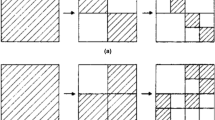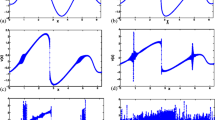Abstract
One of the outstanding unresolved questions of nonlinear dynamics is the relationship between chaos and turbulence. This is a deep and difficult question, not the least reason being that the definitions of “chaos” and “turbulence” are not universally agreed upon. Here we define chaos as the time history of a single descriptor of a deterministic dynamical system which undergoes a loss of temporal correlation with a change in some system parameter and that displays sensitivity to initial conditions. Turbulence is defined as the time history of the spatial distribution of a deterministic dynamical system which undergoes a loss of temporaland (subsequently) spatial correlation with a change in some system parameter(s). By analogy and numerical simulation it is argued that turbulence can be a consequence of multi-mode interaction of individually chaotic modes. The physical system used here is a fluttering panel in a supersonic airstream.
a m = modal amplitude coefficients
D = panel stiffness (=Eh 212(1−v 2))
E = modulus of elasticity of panel material
h = panel thickness
k = dimensional foundation stiffness
K = nondimensional foundation stiffness (=kL 4/Dh)
L = length of panel in direction of flow
M = Mach number
N = number of modes in series expansion of panel deflection
N fv/pa = dimensional applied inplane load
Δp = dimensional static pressure differential across panel
P = nondimensional static pressure differential across panel (=ΔpL 4/Dh)
q = dimensional dynamic pressure (=ρχ U 2/2)
R v = nondimensional inplane load (=N fx paa2/D)
t = dimensional time
T = period over which correlation is averaged
U = dimensional flow velocity
w = dimensional panel deflection
W = nondimensional panel deflection (deflection/h)
x = dimensional coordinate along panel
α = inplane spring stiffness parameter
λ = nondimensional dynamic pressure of flow over panel (\(\begin{gathered} \hfill \\ \left( { = 2qL^3 /D\sqrt {M^2 - 1} } \right) \hfill \\ \end{gathered} \))
μ = mass ratio (ρχL/ρmh))
ν = Poisson's ratio
ξ = nondimensional location along panel (x/L)
Δξ = separation between points used in correlation function
ξu = nondimensional correlation length
ψ = correlation function
Similar content being viewed by others
References
Gollub, J. P. and Ramshankar, R., ‘Spatiotemporal chaos in interfacial waves,’ in Sirovich L. (ed.),New Perspectives in Turbulence, Springer-Verlag, New York, NY, 1991, 165–194.
Tufillaro, N. B., Ramshankar, R., and Gollub, J. P., ‘Order-disorder transition in capillary ripples,’Physical Review Letters 62, 1989, 422–425.
Aubry, N., Holmes, P., Lumley, J. L., and Stone, E., ‘The dynamics of coherent structures in the wall region of a turbulent boundary layer,Journal of Fluid Mechanics 192, 1988, 115–173.
Holmes, P. J., ‘Can dynamical systems approach turbulence?,’ in LumleyJ. L. (ed.),Whither Turbulence? Turbulence at the Crossroads, Lecture Notes in Physics,357, Springer-Verlag, Berlin, Germany, 1990, 195–249.
Manley, O. P., ‘Finite dimensional aspects of turbulent flows,’ in ChandraJ. (ed.),Chaos in Dynamical Systems, SIAM, Philadelphia, PA, 1984, 165–175.
Dowell, E. H. and Virgin, L. N., ‘On spatial chaos, asymptotic modal analysis, and turbulence,’Journal of Applied Mechanics 57, 1990, 1094–1097.
Dowell, E. H. and Kubota, Y., ‘Asymptotic modal analysis and statistical energy analysis of dynamical systems.’Journal of Applied Mechanics 52, 1985, 949–957.
Johnson, J. M., and Bajaj, A. K., ‘Amplitude modulated and chaotic dynamics in resonant motion of strings,’Journal of Sound and Vibration 128, 1989, 87–107.
Dowell, E. H. and Pezeshki, C., ‘On the understanding of chaos in Duffing's equation including a comparison with experiment,’Journal of Applied Mechanics 53, 1986, 5–9.
Pezeshki, C. and Dowell, E. H., ‘An examination of initial condition maps for the sinusoidally excited buckled beam modelled by the Duffing's equation,’Journal of Sound and Vibration 117, 1987, 219–232.
Tang, D. M. and Dowell, E. H., ‘Comparison of theory and experiment for nonlinear flutter and stall response of a helicopter blade,’Journal of Sound and Vibration 162, 1993.
Moon, F. C., ‘Experiments on chaotic motions of a forced nonlinear oscillator: Strange attractors,’Journal of Applied Mechanics 47, 1980, 638–644.
Umberger, D K., Grebogi, C., Ott, E., and Afeyan, B., ‘Spatiotemporal dynamics in a dispersively coupled chain of nonlinear oscillators,’Physical Review A 39, 1989, 4835–4842.
Dowell, E. H., ‘Flutter of a buckled panel as an example of chaotic motion of a deterministic autonomous system,’Journal of Sound and Vibration 85, 1982, 333–344.
Dowell, E. H., ‘Observation and evolution of chaos for an autonomous system,’Journal of Applied Mechanics 51, 1984, 664–673.
Holmes, P. J., ‘Bifurcations to divergence and flutter in flow induced oscillations: A finite dimensional analysis,’Journal of Sound and Vibration 53, 1977, 471–503.
Dowell, E. H., ‘Nonlinear oscillations of a fluttering panel,’AIAA Journal 4, 1966, 1267–1275.
Hohenberg, P. C. and Shraiman, B. I., ‘Chaotic behavior in an extended system,’Physica D 37, 1989, 109–115.
Author information
Authors and Affiliations
Additional information
1. Nomenclature
Rights and permissions
About this article
Cite this article
Reynolds, R.R., Virgin, L.N. & Dowell, E.H. High-dimensional chaos can lead to weak turbulence. Nonlinear Dyn 4, 531–546 (1993). https://doi.org/10.1007/BF00162231
Received:
Accepted:
Issue Date:
DOI: https://doi.org/10.1007/BF00162231




